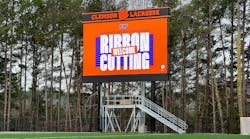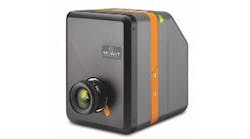Date Announced: 13 Jan 2009 Cree Announces University of California, Davis Joins LED University™ Program and Unveils Bi-level ‘Smart’ Parking Lighting at South Entry Parking Garage DAVIS, CALIF., JANUARY 13, 2009 — Cree, Inc. (Nasdaq: CREE), a leader in LED lighting, announces that University of California, Davis is joining the LED University™ program in conjunction with the unveiling of new bi-level LED lighting at UC Davis’ South Entry Parking Structure near the Robert and Margrit Mondavi Center for the Performing Arts. The LED light fixtures, featuring activity-sensing technology adapted and developed at California Lighting Technology Center (CLTC) at UC Davis, provide enhanced nighttime visibility while reducing energy consumption by up to 80 percent compared with the metal-halide fixtures that were replaced.Switching to LED lights and adding bi-level activity-sensing technology yields energy savings for the project averaging 50 percent. In low mode, energy savings are up to 80 percent. The university installed 50 BetaLED™ fixtures in this project and according to the university, based on nighttime, bi-level operation with an average ambient temperature near 15⁰C, the luminaires should require no relamping and be virtually maintenance free for 20 to 25 years.“With LED lighting, we are improving visibility and enhancing the safety of our parking structure while reducing energy consumption,” said Chris Cioni, associate director of UC Davis facilities management, utilities division. “We are also significantly reducing both maintenance costs and light trespass compared to the incumbent metal-halide technology. Deploying LED lighting in our parking facilities yields benefits in many areas, and we plan to evaluate LED lighting in other applications.”“Our initial LED lighting installation is part of California Lighting Technology Center’s Smart Lighting Initiative, an effort we have pursued over the past two years to utilize high-efficiency lighting sources with bi-level activity sensors to reduce lighting levels when no one is using the parking facility,” said Michael Siminovitch, CLTC director. “Even at half-power, the LED fixtures are delivering plenty of light to the space. We may be able to cut levels further, saving even more electricity and lengthening fixture lifetimes.”Safety can be improved with the bi-level system. When motion is detected and the higher light mode is activated, the change in the visual environment alerts people nearby. Drivers, pedestrians and security agents now have an indicator when there is activity in the area.UC Davis joins LED University participants North Carolina State University, Marquette University, University of California, Santa Barbara, University of Arkansas, Madison Area Technical College, Notre Dame, and Tianjin Polytechnic University in China in evaluating, promoting, and deploying LED lighting as they work toward increasing energy savings, protecting the environment, reducing maintenance costs, and providing better light quality for improved visibility and safety.About University of California, DavisFor 100 years, UC Davis has engaged in teaching, research and public service that matter to California and transform the world. Located close to Sacramento, UC Davis has 31,000 students, an annual research budget that exceeds $500 million, a comprehensive health system, and 13 specialized research centers. The university offers interdisciplinary graduate study and more than 100 undergraduate majors in four colleges — Agricultural and Environmental Sciences, Biological Sciences, Engineering, and Letters and Science — and advanced degrees from five professional schools: Education, Law, Management, Medicine, and Veterinary Medicine. The UC Davis School of Medicine and UC Davis Medical Center are located at the Sacramento campus.About California Lighting Technology CenterCalifornia Lighting Technology Center (CLTC), within the Design Program at UC Davis, is a research and education facility that focuses on the application of energy-efficient lighting and daylighting technologies through research, development, demonstration, outreach, and education in partnership with utilities, manufacturers, end users, builders, designers, and governmental agencies. CLTC was established through a collaborative effort of the California Energy Commission’s Public Interest Energy Research (PIER) Program and the University of California, Davis, with support from the U.S. Department of Energy and the National Electrical Manufacturers Association to advance energy efficient lighting and daylighting technologies. For more information, refer to http://cltc.ucdavis.edu.About LED UniversityThe LED University initiative is a growing international community of universities working to evaluate, deploy, and promote LED lighting across their campus infrastructures to save energy, protect the environment, reduce maintenance costs, and provide better light quality for improved visibility and safety.According to the U.S. Department of Energy, 22 percent of electricity used in the U.S. powers lighting. In a world with soaring energy prices based on the availability and control of fossil fuels, and with growing concern about sustainability of the environment, a revolution in lighting is long overdue. Details of each university’s LED lighting pilots and installations are available on the LED University web site: www.leduniversity.org. About BetaLEDBetaLED, a brand of Beta Lighting, was established to dedicate resources to the emerging use of LED technology for general illumination. Beta Lighting, a Wisconsin-based Ruud Lighting company, provides the lighting industry with high-quality, specification-grade luminaires for exterior lighting applications. About Cree, Inc.Cree, Inc. is leading the LED lighting revolution and setting the stage to obsolete the incandescent light bulb through the use of energy-efficient, environmentally friendly LED lighting. Cree is a market-leading innovator of lighting-class LEDs, LED lighting solutions, and semiconductor solutions for wireless and power applications.Cree’s product families include recessed LED down lights, blue and green LED chips, high-brightness LEDs, lighting-class power LEDs, power-switching devices and radio-frequency/wireless devices. Cree solutions are driving improvements in applications such as general illumination, backlighting, electronic signs and signals, variable-speed motors, and wireless communications.Cree is a registered trademark and LED University is a trademark of Cree, Inc.BetaLED is a trademark of Ruud Lighting, Inc.
Contact
Contact Cree, Inc Durham, NC
E-mail:[email protected]
Web Site:www.cree.com




